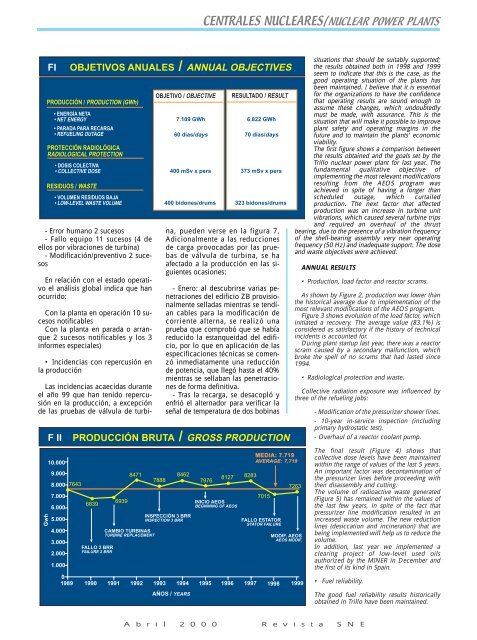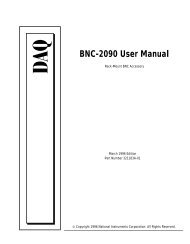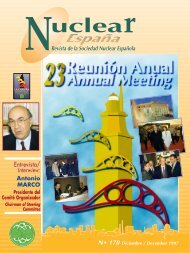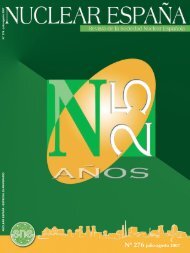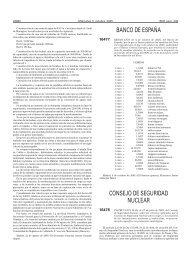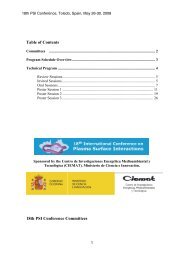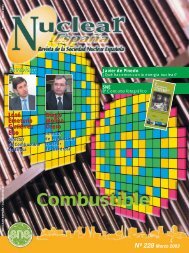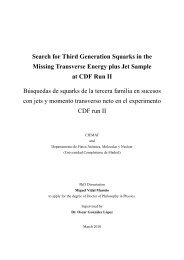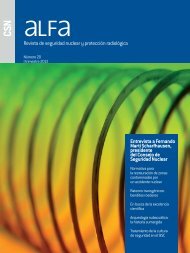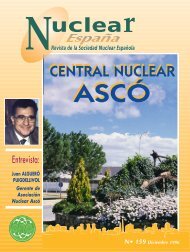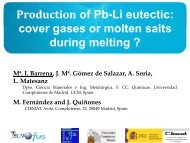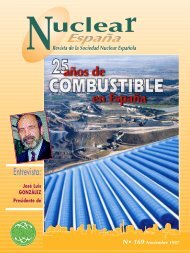EntrEntr evista/evista/ InterInter viewview
EntrEntr evista/evista/ InterInter viewview
EntrEntr evista/evista/ InterInter viewview
You also want an ePaper? Increase the reach of your titles
YUMPU automatically turns print PDFs into web optimized ePapers that Google loves.
CENTRALES NUCLEARES/NUCLEAR POWER PLANTS<br />
FI<br />
OBJETIVOS ANUALES / ANNUAL OBJECTIVES<br />
PRODUCCIÓN / PRODUCTION (GWh)<br />
• ENERGÍA NETA<br />
• NET ENERGY<br />
• PARADA PARA RECARGA<br />
• REFUELING OUTAGE<br />
- Error humano 2 sucesos<br />
- Fallo equipo 11 sucesos (4 de<br />
ellos por vibraciones de turbina)<br />
- Modificación/preventivo 2 sucesos<br />
En relación con el estado operativo<br />
el análisis global indica que han<br />
ocurrido:<br />
Con la planta en operación 10 sucesos<br />
notificables<br />
Con la planta en parada o arranque<br />
2 sucesos notificables y los 3<br />
informes especiales)<br />
• Incidencias con repercusión en<br />
la producción<br />
Gwh<br />
PROTECCIÓN RADIOLÓGICA<br />
RADIOLOGICAL PROTECTION<br />
• DOSIS COLECTIVA<br />
• COLLECTIVE DOSE<br />
RESIDUOS / WASTE<br />
• VOLUMEN RESIDUOS BAJA<br />
• LOW-LEVEL WASTE VOLUME<br />
F II<br />
10.000<br />
9.000<br />
OBJETIVO / OBJECTIVE RESULTADO / RESULT<br />
7.109 GWh<br />
60 días/days<br />
400 mSv x pers<br />
6.822 GWh<br />
70 días/days<br />
373 mSv x pers<br />
400 bidones/drums 323 bidones/drums<br />
Las incidencias acaecidas durante<br />
el año 99 que han tenido repercusión<br />
en la producción, a excepción<br />
de las pruebas de válvula de turbina,<br />
pueden verse en la figura 7.<br />
Adicionalmente a las reducciones<br />
de carga provocadas por las pruebas<br />
de válvula de turbina, se ha<br />
afectado a la producción en las siguientes<br />
ocasiones:<br />
- Enero: al descubrirse varias penetraciones<br />
del edificio ZB provisionalmente<br />
selladas mientras se tendían<br />
cables para la modificación de<br />
corriente alterna, se realizó una<br />
prueba que comprobó que se había<br />
reducido la estanqueidad del edificio,<br />
por lo que en aplicación de las<br />
especificaciones técnicas se comenzó<br />
inmediatamente una reducción<br />
de potencia, que llegó hasta el 40%<br />
mientras se sellaban las penetraciones<br />
de forma definitiva.<br />
- Tras la recarga, se desacopló y<br />
enfrió el alternador para verificar la<br />
señal de temperatura de dos bobinas<br />
PRODUCCIÓN BRUTA / GROSS PRODUCTION<br />
8.000 7643<br />
7.000<br />
6839<br />
6.000<br />
5.000<br />
4.000<br />
3.000<br />
2.000<br />
1.000<br />
FALLO 2 BRR<br />
FAILURE 2 BRR<br />
6939<br />
8471<br />
CAMBIO TURBINAS<br />
TURBINE REPLACEMENT<br />
7888<br />
8462<br />
7976<br />
8127 8283<br />
INICIO AEOS<br />
BEGINNING OF AEOS<br />
INSPECCIÓN 3 BRR<br />
INSPECTION 3 BRR<br />
0<br />
1989 1990 1991 1992 1993 1994 1995 1996 1997<br />
AÑOS / YEARS<br />
MEDIA: 7.719<br />
AVERAGE: 7,719<br />
7015<br />
FALLO ESTATOR<br />
STATOR FAILURE<br />
1998<br />
situations that should be suitably supported;<br />
the results obtained both in 1998 and 1999<br />
seem to indicate that this is the case, as the<br />
good operating situation of the plants has<br />
been maintained. I believe that it is essential<br />
for the organizations to have the confidence<br />
that operating results are sound enough to<br />
assume these changes, which undoubtedly<br />
must be made, with assurance. This is the<br />
situation that will make it possible to improve<br />
plant safety and operating margins in the<br />
future and to maintain the plants’ economic<br />
viability.<br />
The first figure shows a comparison between<br />
the results obtained and the goals set by the<br />
Trillo nuclear power plant for last year. The<br />
fundamental qualitative objective of<br />
implementing the most relevant modifications<br />
resulting from the AEOS program was<br />
achieved in spite of having a longer than<br />
scheduled outage, which curtailed<br />
production. The next factor that affected<br />
production was an increase in turbine unit<br />
vibrations, which caused several turbine trips<br />
and required an overhaul of the thrust<br />
bearing, due to the presence of a vibration frequency<br />
of the shell-bearing assembly very near operating<br />
frequency (50 Hz) and inadequate support. The dose<br />
and waste objectives were achieved.<br />
ANNUAL RESULTS<br />
• Production, load factor and reactor scrams.<br />
As shown by Figure 2, production was lower than<br />
the historical average due to implementation of the<br />
most relevant modifications of the AEOS program.<br />
Figure 3 shows evolution of the load factor, which<br />
initiated a recovery. The average value (83.1%) is<br />
considered as satisfactory if the history of technical<br />
incidents is accounted for.<br />
During plant startup last year, there was a reactor<br />
scram caused by a secondary malfunction, which<br />
broke the spell of no scrams that had lasted since<br />
1994.<br />
• Radiological protection and waste.<br />
Collective radiation exposure was influenced by<br />
three of the refueling jobs:<br />
7263<br />
MODIF. AEOS<br />
AEOS MODIF.<br />
1999<br />
- Modification of the pressurizer shower lines.<br />
- 10-year in-service inspection (including<br />
primary hydrostatic test).<br />
- Overhaul of a reactor coolant pump.<br />
The final result (Figure 4) shows that<br />
collective dose levels have been maintained<br />
within the range of values of the last 5 years.<br />
An important factor was decontamination of<br />
the pressurizer lines before proceeding with<br />
their disassembly and cutting.<br />
The volume of radioactive waste generated<br />
(Figure 5) has remained within the values of<br />
the last few years, in spite of the fact that<br />
pressurizer line modification resulted in an<br />
increased waste volume. The new reduction<br />
lines (desiccation and incineration) that are<br />
being implemented will help us to reduce the<br />
volume.<br />
In addition, last year we implemented a<br />
clearing project of low-level used oils<br />
authorized by the MINER in December and<br />
the first of its kind in Spain.<br />
• Fuel reliability.<br />
The good fuel reliability results historically<br />
obtained in Trillo have been maintained.<br />
A b r i l 2 0 0 0<br />
R e v i s t a S N E


